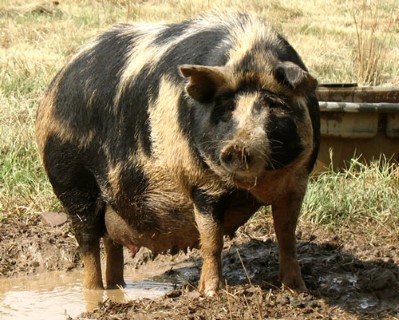Ossabaw Island hogs, or Ossabaw Island pigs, is a breed of pig derived from a population of feral pigs on Ossabaw Island, Georgia, United States. The original Ossabaw hogs are descended from swine released on the island in the 16th century by Spanish explorers. A breeding population has been established on American farms off the island, but they remain a critically endangered variety of pig.
Originally, Ossabaw Island pigs were small, domesticated Spanish range pigs with pricked ears, heavy coats, and long snouts. Over time, some of the pigs escaped and became feral in southeastern forests. While most feral pigs eventually mixed with domestic pigs, the Ossabaw Island pigs are an exception, having remained a distinct and isolated population. Thus, they reflect their Spanish heritage more closely.
They are found in several colors including black, black and white, and red and tan.
The Ossabaw Island pigs have adapted to Ossabaw Island and have become smaller over time. Males can weigh over 200 pounds (90.7 kg) and females range from 100 to 150 pounds (45 to 68 kg).
Ossabaw Island lies twenty miles south of Savannah, Georgia, Ossabaw Island is the northernmost member of the historically defined Golden Isles. Island habitat includes rich salt marshes, freshwater ponds, ancient maritime forest, wind-swept dunes and deserted white beaches. Shaped like a wishbone with marsh filling the middle, the island consists of 25,000 acres, of which 11,800 are upland and almost 10 miles are beach, making it roughly twice the size of Bermuda and counting total acreage the second largest barrier island on the Georgia coast.
Roots and tubers constitute the main food available in winter; however, leeches, earthworms, insects and fiddler crabs are found in the spring and summer.
They had to adapt to the food cycle on the island, which provides little to eat during the spring season. As an adjustment, the Ossabaw Island hogs developed a unique biochemical system of fat metabolism, enabling them to store a larger proportion of fat than any other hog. In conjunction with this, they have a form of low-grade, non-insulin-dependent diabetes, making them excellent medical research animals.

